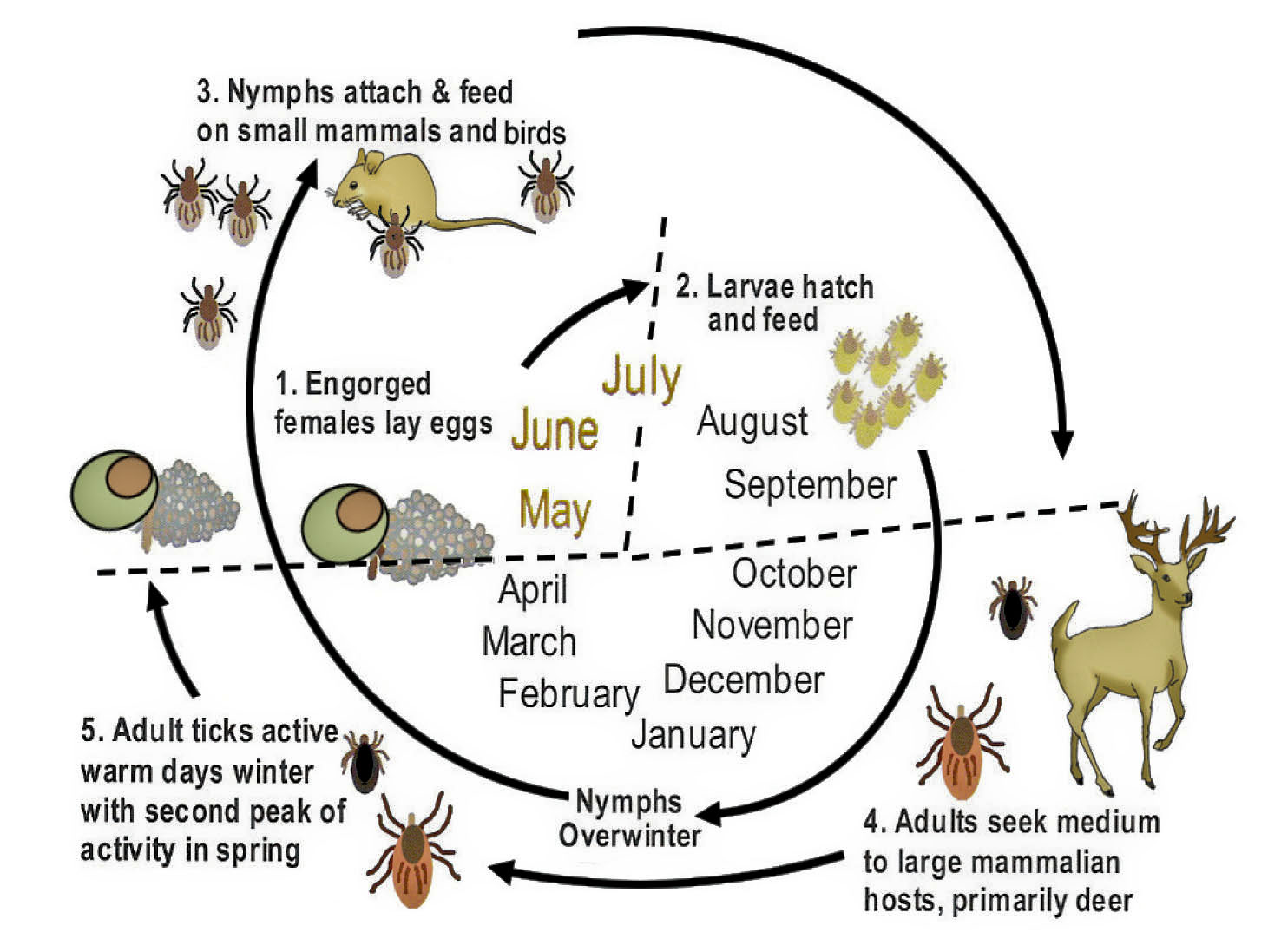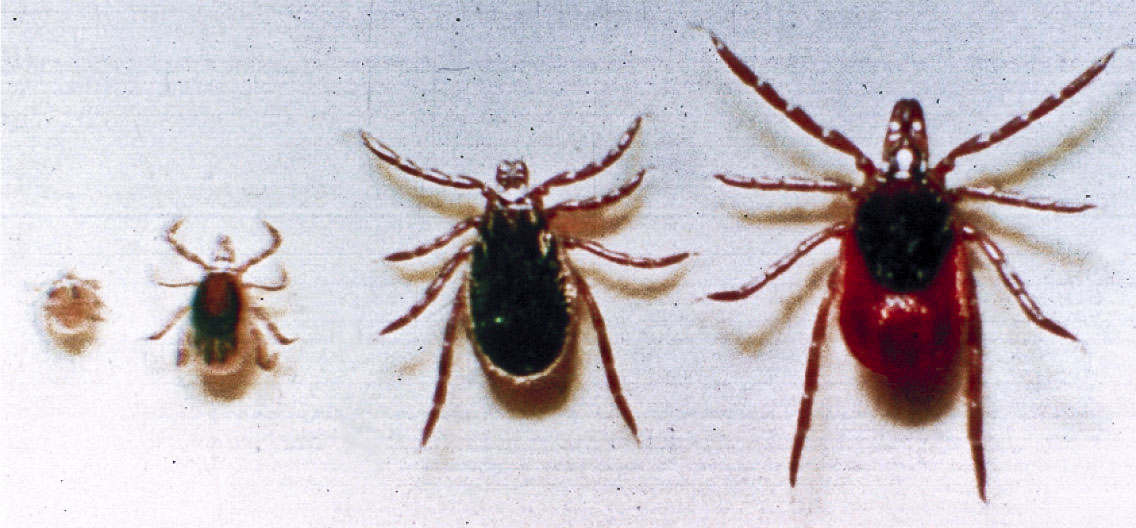Tick Talk: Guest Blog by Nick Rhodehamel
High above the Wabash River with night falling, it was still almost as hot and humid as it had been all the way across Missouri and Illinois. Now with the flat tire, it seemed unlikely that I’d make it the remaining 330 odd miles home that night.
As I removed the jack and straightened up, the earth moved. I blinked and looked again. It was not an effect of my inner ear adjusting from a prone to an upright position but ticks. There were hundreds of them moving from the tall grass at the side of the road and across the pavement toward the car but specifically toward me. Those that I saw were the main body; the vanguard had reached me before I saw the others and were already crawling on my clothes and body. I threw them out of the car as I found them as I drove.
Those ticks were relatively large and probably the common American dog (or eastern wood) tick (Dermacentor variabilis), but conceivably they could have been any of the other 15 tick species found in that part of the country. In the USA, there are about 80 tick species; worldwide, there are about 865.
Ticks are arachnids, as are mites, spiders, and true scorpions. Arachnids have eight legs, two body sections, and no antennae. Almost all extant arachnids are terrestrial, and almost all are carnivorous, mostly predigesting before consuming their food.
Ticks are great vectors for disease transmission; they are obligate blood feeders that require an animal host to survive and reproduce. They parasitize a variety of mammals, birds, reptiles, and some amphibians. They transmit a mix of human and other animal pathogens such as bacteria, protozoa, and viruses. Sometimes they carry and transmit more than one pathogen at a time. Of the 80 tick species in North America, 12 are associated with at least 11 discrete human diseases, both infectious and toxic.
The American dog tick carries the organism that causes Rocky Mountain spotted fever, one of the most commonly reported and most fatal tick-borne diseases in the USA. But Lyme disease is what’s on people’s minds; and for good reason–it’s the most common vector-borne illness in the USA with 29,959 reported cases in 2009. About 95% of Lyme disease cases are from 12 states (http://www.cdc.gov/lyme/stats/index.html), but Lyme disease is found in 49 states, parts of Canada, and across Europe and Asia.
Lyme disease is caused by the corkscrew-shaped bacterium Borrelia burgdorferi. It is transmitted primarily by blacklegged (or deer) tick (Ixodes scapularis) but also by some other Ixodes species. Blacklegged tick is most common in the Upper Midwest, Northeast, and mid Atlantic region. On the Pacific coast, it is the western blacklegged tick (I. pacificus) that spreads the disease.
Blacklegged tick has a 2-year life cycle (Fig. 1) that includes four stages (eggs, six-legged larvae, and eight-legged nymphs and adults) (Photo 1). In spring or early summer, the larval ticks hatch from eggs that were laid in the soil that same year in late winter or early spring; larvae attach themselves to small animals, feed, molt, and become nymphs.
After hatching and before feeding, blacklegged tick larvae are not infectious. The larvae must acquire the Lyme disease bacterium from a mammal host that acts as a reservoir of the Lyme disease bacterium, and white-footed mouse (Photo 2) is the main reservoir of that pathogen. But even after feeding, no more than 40% of them are infectious.
The nymphs rest during winter, often in white-footed mouse burrows, become active the following spring, and seek a new host. After nymphs feed, they again molt to become adults. Adults can live a year or more without feeding, but when they feed, generally on large mammals such as deer (Photo 3), they then mate and the cycle begins again with females laying eggs.
The probability of getting any tick-borne disease, especially Lyme disease, is relatively low. Ticks transmit infection only after they have attached to and fed on a host. To transmit the Lyme disease bacterium, a tick must carry the bacterium, bite, and feed on a host for more than 36 hours, generally about 2 days. The probability of acquiring Lyme disease after having been bitten is less than 2%.
Most cases of Lyme disease, though, are contracted from nymphs, largely because nymphs are so small (less than 2 mm, about the thickness of a U.S. penny) and easy to overlook. They are also most active in late spring and summer when people tend to be outdoors. Adult ticks are most active in fall, warm winter days, and early spring when outdoor activity is more limited.
The low probability of contracting a tick-borne disease is cold comfort though to anyone who’s gotten one, but there are lots of ways to reduce the chances further. It’s most effective to implement an integrated approach that involves personal protection, tick habitat modification around your yard or garden, and perhaps preemptive pesticide spraying or other methods of controlling local tick populations.
Begin with yourself though. If you’re going out where there are ticks, use tick repellents. DEET-based products will repel ticks, but they will not provide complete protection against them. Permethrin is a synthetic pyrethroid that kills ticks. EPA lists it as a potential carcinogen, but when used on clothes only, it poses little risk: it is not readily absorbed through skin and is quickly metabolized and excreted. There are a number of permethrin-based repellents on the market.
Wear light-colored clothing and long pants. Tuck pants into socks. This makes it easier to see ticks and tends to keep them from getting inside clothes. The bite of ticks is usually painless, so after being out where ticks are present, check yourself (and children and dogs) well, being mindful of the size of the tick you’re looking for and where they like to hide–hair, waistband of clothing, armpit.
Modify the area around your house or garden to make it less hospitable to ticks and their hosts. Keep your grass well mowed. Ticks don’t fly or jump but rely on catching hold of a passing host. If you have pathways through a garden or yard with overgrown bushes or shrubs, prune or remove them. Prune or remove trees to increase sunlight and air circulation. Remove ground covers and weeds that border your lawn. Woodchip or gravel walkways or barriers between a wooded area and the yard reduce tick movement. Consider locating children’s playsets within an island of woodchips.
Tick pesticides (or acaricides) are effective at reducing tick populations. In most areas where ticks are a problem, there are commercial services that will apply these. A service is probably easiest for most people, but it is possible to do it yourself. A typical program consists of spring, summer, and fall acaricide applications. Application times and frequencies can be modified as needed. Both organic and synthetic acaricides are available. Consult garden centers and/or county agricultural agents for more information.
The Lyme disease bacterium is transmitted to larval and nymphal blacklegged ticks in eastern North America mostly by white-footed mice. There is a commercial product (Damminix Tick Tube) targeting ticks associated with white-footed mice (and other small rodents) that utilizes a cardboard tube containing permethrin-impregnated cotton balls. The tubes are distributed throughout the mouse habitat (your garden and/or yard) and mice collect the cotton balls for nesting material. The permethrin then kills the tick larvae and nymphs overwintering in mouse burrows. Permethrin has essentially no effect on the mice. My understanding is that this product has shown only mixed success in reducing tick populations.
White-tailed deer is the major host of adult blacklegged ticks in eastern North America. The USDA-ARS has developed a device that treats deer with an acaricide. USDA-ARS calls this device a “4-poster”; the device consists of a bait (corn, for example) to attract deer and four paint rollers that apply an acaricide to deer while they feed. Bait can, in addition, be laced with a systemic acaricide that is not harmful to deer but kills ticks that bite them. This apparatus or its modifications is commercially available from several sources. It is probably not appropriate for a small lot but may be a good alternative to broad, nontargetted use of acaricides or drastically reducing deer populations by culling.
Finally, there are several insect-pathogenic fungi (such as Beauveria bassiana and Metarhizium anisopliae) that also parasitize ticks. Laboratory and field studies suggest these fungi may be effective in controlling nymphal blacklegged ticks. These fungi occur naturally in soil and pose minimal risk to nontarget organisms such as bees and butterflies. Commercial products that can be applied as standard pesticides are currently being developed, and these may become important options in future tick management programs.
So, did I get home that night? No. I arrived some time before dawn the next morning. During the day, I found several more ticks still clinging to me–at least one pressed close against my scalp along my hairline and one that I initially took for a scab over my ribs under an arm. None of them had bitten me.





Great article but now I am itching and I have been in the house all day!
Check yourself well, Joan. Thanks for read and writing.
The use of guinea hens has dramatically reduced my problem with ticks in PA and serves the additional task of wireless doorbell on several acres. The description of ticks heading for you is enough to keep me up at night!
Dear Jano,
See Kim’s post above with the link about Guinea hens. Thanks for taking the time to post and for the great information.
What an adventure just changing your tire. I am sure you checked the tire well for ticks. I found a multitude of ticks inside the wheel well after changing a tire last summer.
Dear Robin,
I don’t actually recall the wheel well. The car was an Austin-Healy 100-6, 1959, with triple SU carburetors, which were difficult to synchronize, and electronic overdrive in 3rd and 4th. I had rebuilt most of the car’s system, but the car was way past its prime before I ever saw it, and I was too cheap to replace the tires, which had tubes and had never previously given me any trouble. I had no other spare tire and my real anxiety that night was that I would have another flat and no way to fix it and would be stuck on an interstate with all my stuff in a car that that I couldn’t lock because it barely had a top. It was a bit of an adventure.
My father lives in Wisconsin and got Lyme’s Disease about 15 years ago. He just another tick disease called Ehrlichiosis, a newer one for WI and on the rise. I’ve been researching Guinea hens for him as I hear they eat ticks, they hold interesting possibilities as an eco friendly way to fight off ticks. http://www.lymediseasepa.com/GuineaHens.htm
Did you come across any research about them?
Dear Kim,
Yes, black legged tick also transmits the bacterium that causes ehrlichiosis (also called anaplasmosis). It is also mostly transmitted by nymphal and adult ticks. My understanding is that it’s treated with doxycycline. By the way, the night I was “attacked” by ticks I was on my way to Madison (why was I so far East, you might ask—bad planning). I have not heard that Guinea hens eat tick, but I’m not surprised. See Jano’s post below. They’re supposed to eat Japanese beetles too. In either case, they could be a big help. Thanks for the link and taking time to write; I’ll check it out.
I have a question no doctor has been able to answer. Does an old Lyme infection (decades old) confer protection against a new infection? Or…can one be re-infected?
Thanks.
Karen
Dear Karen,
That’s a great question. I’m not a physician, but my guess is that if there is some immunity from previous infection, it is limited. There was a vaccination available (suggesting that it’s possible to induce some degree of immunity) that was discontinued by the manufacturer in 2002; the reason given was “low demand”. I understand there were reports of side effects to the vaccine that mimicked Lyme disease itself. There does seem to be a lot of information about vaccines and immunity on the internet, but I’m not in a position to evaluate it.